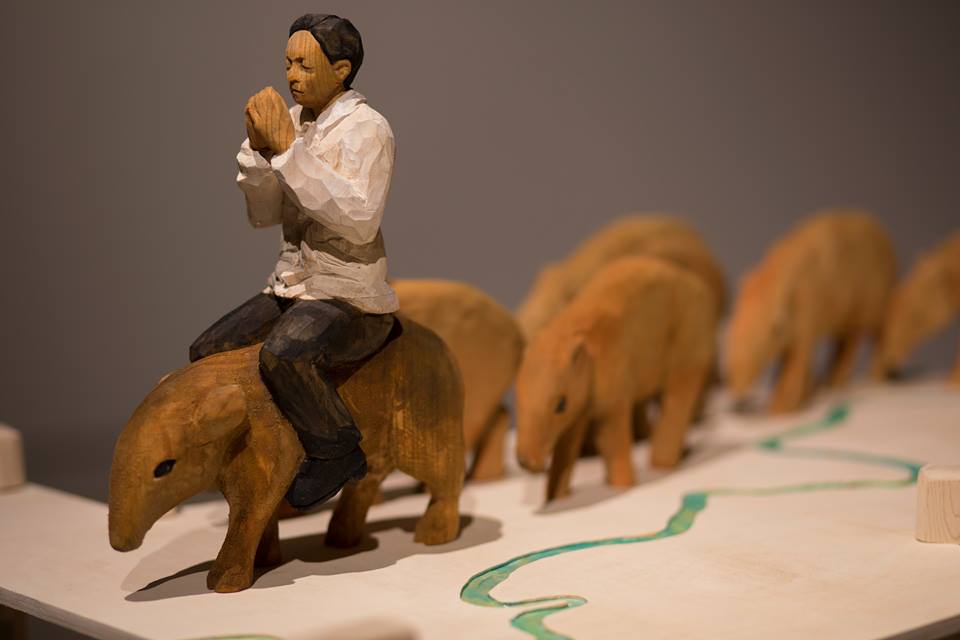
Associate Professor of Art Santiago Cal was one of two artists who participated in “Belize 35,” a 35-year independence anniversary exhibition, at The Organization of American States AMA (Art Museum of the Americas) in Washington, D.C., Feb. 11-March 13.
In September of 2016, the Central American nation of Belize will celebrate the 35th anniversary of its independence from Great Britain. To mark the occasion, the AMA invited Cal, a Belizean sculptor, to create a large installation occupying an entire museum gallery. Cal was born in Belize and lived in Belize at the time of their independence.
Also participating is photographer Karl Villanueva, whose series of photos taken on Sept. 21, 1981, captured Independence Day in Belize.
As he began working on his piece, Cal thought about the questions he had as a child at the moment of independence. Cal was eight years old at the time. He spent his childhood years in the capital city of Belmopan before moving to the U.S. in 1986.
“The first thing that came to mind was the symbolism,” he said. “I remember the Belizean flag, which was basically the British-Honduras flag. And when they said they were going to unveil the new flag for Belize, basically all they did was add two red stripes, one at the top and bottom. And I thought wow, even as a child. Here’s an opportunity to really reform your identity, and that was their solution. That being said, Belize is still in its infancy of the visual language and the visual culture.”
As he contemplated these issues, he began to think about pathways.
“A pathway leads from a start to an end, and from the beginning of independence until today, I was thinking about that,” he said.
To gain independence, there was one figure, named George Price, who helped make it happen.
“He was very humble, a very quiet and diplomatic man,” Cal said. “He really strived and wrote and articulated in many ways in front of all these countries and in front of all these politicians from well over 12 years in favor of Belize getting its independence. I would say he’s the single most powerful force in having that achieved. So even though it’s this tiny country with no voice, no economic power or physical power, he really made it happen through conversations.”
So for his piece, Cal created a pathway, about 15 feet in length. On it, are 35 tapirs he created, one for each year of independence. Tapirs are the national animal of Belize.
“I wanted to include this character, George Price,” Cal said. “So I had him riding or leading the way.”
On the pathway is a navigating line, which represents the Sarstoon River.
“It’s the southernmost border between Belize and Guatemala,” Cal said. “Today, that’s a very contested area full of tension. A river, though, is such a peaceful thing. For it to be a wall, like an abstract wall, it’s very odd for me to think about.”
The pathway is raised above the floor and held up by machetes that Cal made.
“That tool is a cultural fixture,” he said. “You see it all the time. It’s always been a tool that I’ve looked with two faces. One, it aids in your labor, it’s for progress, it’s for development. But it quickly becomes a tool of violence also. It’s that duality I was interested in with the machetes.”
His second piece in the exhibition was “Some Kind,” which was a large collection of hammers that he made.
“I got to represent my interest in tools as a device for the hand,” he said. “I’m interested in physical labor. That’s what I do, and I appreciate that.”
Cal was pleased with the exhibition, which received coverage in the Washington Post and at artdaily.org.
“I thought it was a good exhibition,” he said. “The turnout and the feedback were great.”
This summer, he will have an exhibition at 1point618 Gallery in Cleveland. For both exhibitions, he received Hixson-Lied Endowment support to help create his work.
“I’ll be using more Hixson-Lied support to create a series of works based on interiors and landscapes,” he said. “’Hallways and Roads’ is the first piece. Not unlike that pathway, I’m thinking of these predetermined structures that we travel to navigate spaces.”
He is grateful for the support of the Hixson-Lied Endowment.
“You have no idea how great Nebraska has been to me,” he said. “Certainly the Hixson-Lied Endowment supports my travel and supports my research and material and tools. It also allows me to dream however I want to dream. The support is incredible. The majority of my work would not exist without their funding. I have my career to thank to them.”